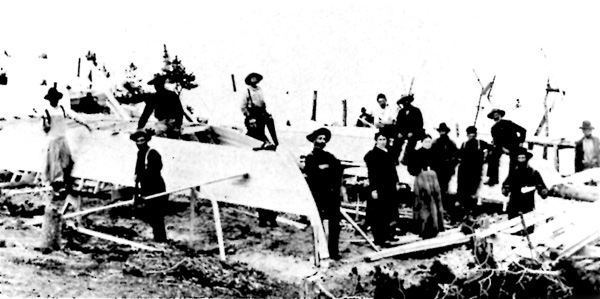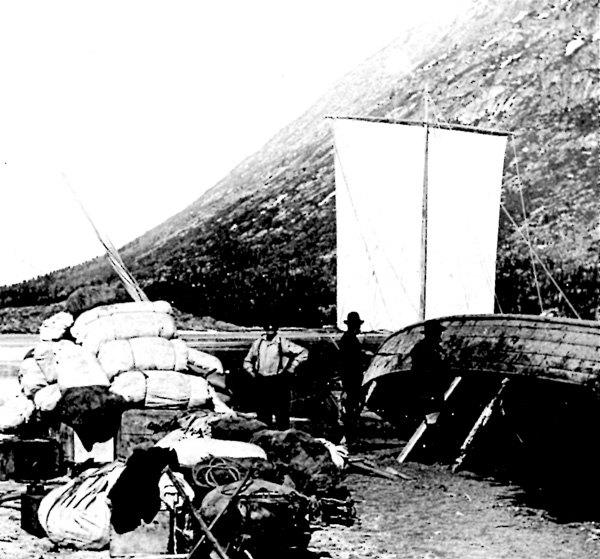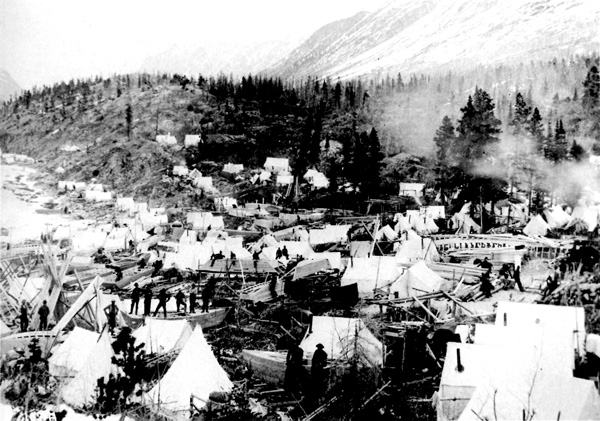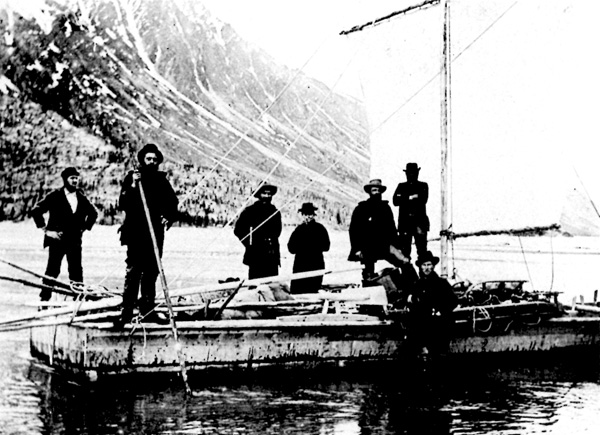|
|
 |
Canadian Historic Sites: Occasional Papers in Archaeology and History No. 26
St. Andrew's Presbyterian Church, Lake Bennett, British Columbia
by Margaret Carter
Cheechako, Canvas and Congregation
The following month amid border hostilities
heightened by the on-going Alaska Boundary Tribunal,1 Dickey
abandoned the church he was occupying in Skagway. He moved on to Bennett
which was at that time considered to be the first certain point inside
Canadian territory. There, he was to assist Grant in securing the
church's position while Grant prepared to move on to Dawson as early as
possible after breakup.
Both men worked to ensure there were quarters to
accommodate the large congregation they expected to find among the
throngs of Klondikers waiting for breakup. The first thing needed was
better church facilities, so they completed on 1 May a large tent of
canvas over a wood frame for use as the church. A scaffold containing a
bell stood in front of it (Fig. 16), but apart from that it looked very
much like the other buildings that were being hastily constructed in
Bennett in the spring of 1898. From that time to the end of the summer
season, Bennett had a constant total population of 10,000.2

16 Whipsawing boards for building a boat. The whipsaw pit put
a strain on many partnerships.
(Yukon Archives, MacBride
Museum Collection.)
|
Anything that could be put together was used as
shelter, for supplies were in great demand. Men lined up in front of the
hastily constructed sawmills for days waiting for boat-building materials
to avoid the rigours of the whip-saw pit (Figs. 17-19).
Dickey and Grant had to compete with the builders when they were ready
to have boards for church seats cut at King's sawmill. Once they finally
got them Grant wrote, "we had to pack the material through the mud a
quarter of a mile, pull it on a hand sled over a mile, then over a
rickety bridge. After that I got a horse and hauled it to the
church."3 The sawdust they used to cover the dirt floor
probably came from the same source.

17 Building a boat.
(University of Washington.)
|

18 Caulking a boat with oakum and pitch. Note the mast is made
of poles, and the sail is probably handmade.
(R.N. DeArmond,
Juneau.)
|

19 Boat building at Abbott's Cove, Lake Benneett 1898—a typical
boat-building camp. (Provincial Museum and Archives of Alberta, H.
Pollard Collection.)
|
Conditions were crude, and many of the men who waited around the lake
for the ice to melt found themselves in unfamiliar roles. "The men who
run the saloons are, with one exception, I think new to the business and
ashamed of being in it. One of them — a member of the 'Christian
Church' — one day showed us his family Bible rolled up carefully in
a silk hankerchief. The others often apologize for being in the
trade."4 Like their saloon keepers, most of the Klondikers at
Bennett felt ill at ease in their bid tor fortune. By the spring of
1898, the rich claims in the Klondike were already taken. In spite of
this fact, the largest influx of population was either waiting at
Bennett for the ice to break, or still en route north. After they
arrived in Dawson, these men would work on claims owned by a fortunate
few and find employment in service industries. Before that, they paid
dearly for the opportunity to watch their dreams dissolve. Scalpers
charged such heavy prices for services that more profit was probably
made from the prospective millionaires than was ever made from mining;
nevertheless, at Bennett this was still in the future, and few were
ready to turn back and give up their "prospects." Yet they were uneasy.
The church was a reminder of what they had left behind, and some reached
out for the comfort of familiarity. For the first time, Dickey was able
to report "people interested."5
The spring of 1898 brought a new attitude toward the church. As the
gathering at the head of the lake grew, the congregation increased, and
soon it outstripped accommodations. The collection plate also showed
improvement — "The liberality of the people, specially considering
that so many have little or no money, is very marked. Their ordinary
Sabbath collections have gone as high as $27."6 "You will be
pleased to learn," wrote Dickey to Robertson in May,
that the tent and cost of erection have now been paid for by the
people here. At our last meeting a Mr. Elliot enquired how much was the
debt, and, on being informed $50, he said 'We'll pay it tonight.' He
and Capt. Jack Crawford spoke to the people in very enthusiastic terms
of the enterprise of the Presbyterian Church in Canada in so promptly
following up the people. They passed round the hat, and in a few minutes
had more money than was needed. In the name of the Church and myself I
thanked the people for this and all their kindness, assuring them that,
while the home Church is sufficiently interested in the work and
generous enough to bear the expense, yet the liberality of the people
here will not only cheer their hearts, but enable them to undertake more
vigorously still mission work in this new and needy
land.7
In part, the change was a tribute to Dickey's and Grant's work, but
to a larger degree it was a manifestation of the changed nature of the
gold-rush itself.

20 Ready to leave.
(R.N. DeArmond, Juneau.)
|
|

